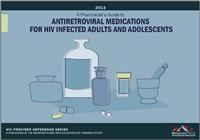Visit Website:
This pamphlet is a guideline to pharmacists on the use of antiretroviral drugs for the treatment of HIV. It discusses the important role of pharmacists in helping patients and clinicians with antiretroviral therapy (ART) considering the changes in treatment options, toxicities and side effects of ART, development of resistance, and problems of adherence. The pamphlet lists the five classes of antiretroviral drugs with explanations: nucleoside reverse transcriptase inhibitors, nucleotide reverse transcriptase inhibitors, nonnucleoside reverse transcriptase inhibitors, protease inhibitors, and fusion inhibitors. The guidelines provide recommendations on when to begin therapy, which combinations have the best efficacy, use of ART in patients with drug resistance, or in specific populations including adolescents, injecting drug users, patients coinfected with hepatitis or TB, and women of child-bearing age. Guidelines also provide information on treatment of pregnant women, prevention of perinatal transmission, and for post-exposure prophylaxis such as occupational and nonoccupational exposures. The pamphlet also include a post test for continuing education credit.
Publication Date:
2013
ID:
35708
- Health Professionals
- HIV and AIDS
- HIV and AIDS Prevention
- MDR TB


